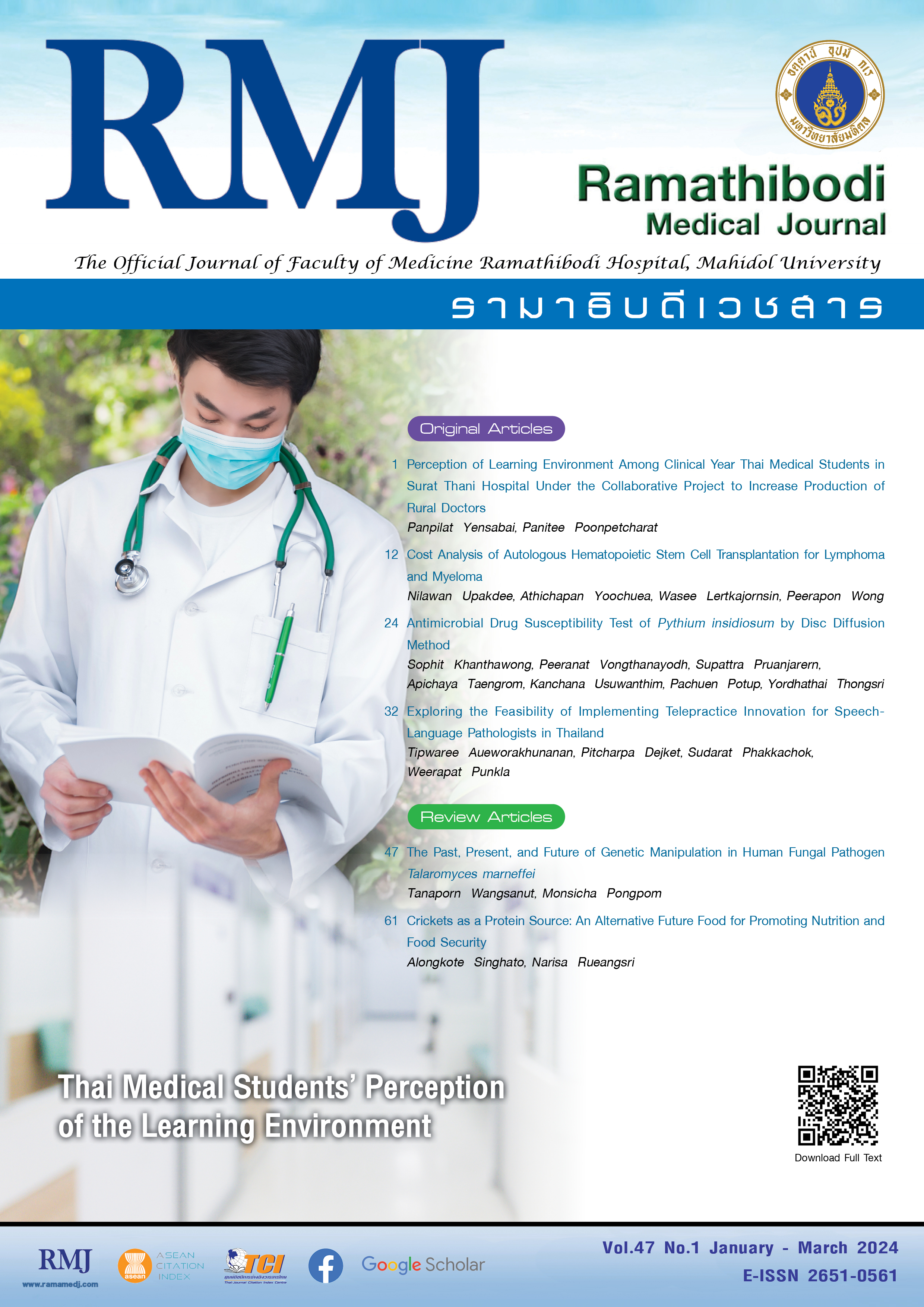Exploring the Feasibility of Implementing Telepractice Innovation for Speech-Language Pathologists in Thailand
DOI:
https://doi.org/10.33165/rmj.2024.47.1.266036Keywords:
Speech-language pathologist, Telepractice, Innovation, AttitudeAbstract
Background: The speech clinic at Ramathibodi Hospital has been using telepractice for 2 years. These outcomes have clearly shown many benefits. It is a new system in Thailand that has not been studied in terms of innovation before.
Objective: To explore the possibility of speech-language pathologists (SLPs) in Thailand implementing the telepractice innovation through a survey of their attitudes toward the characteristics, diffusion, and limitations of innovation.
Methods: In this survey study, SLPs responded to a questionnaire. Data regarding SLPs’ attitudes toward telepractice innovation were collected and then analyzed using descriptive and inferential statistics.
Results: A total of 86 SLPs responded, who agreed characteristics, diffusion, and both were 54.66%, 45.34%, and 37.21%, respectively, most of them used telepractice. SLPs who used telepractice expressed limitations from patients at 52.24% and SLPs who did not use telepractice expressed limitations from systems at 47.36%.
Conclusions: SLPs in Thailand equally expressed attitudes of agreement and disagreement toward the characteristics and diffusion of telepractice innovation. However, SLPs who used telepractice agreed more than those who did not. SLPs agreed on the characteristic of telepractice innovation, though not all of them agreed to the diffusion of telepractice. The limitations of telepractice innovation depended on SLPs’ telepractice experience, occurring from patients for SLPs who used telepractice, but from the system for SLPs who did not. Therefore, telepractice may be an option that can be used according to the needs of the patients and its appropriateness for specific situations.
References
Office of the Royal Society. The Royal Institute Dictionary. Accessed November 4, 2023. https://dictionary.orst.go.th/
Rogers EM. Diffusion of Innovations. 4th ed. Free Press; 2010.
Gaggioli A, di Carlo S, Mantovani F, Castelnuovo G, Riva G. A telemedicine survey among Milan doctors. J Telemed Telecare. 2005;11(1):29-34. doi:10.1177/1357633X0501100107
Iqbal M, Zahidie A. Diffusion of innovations: a guiding framework for public health. Scand J Public Health. 2022;50(5):533-537. doi:10.1177/14034948211014104
Scott J. Social Network Analysis: A Handbook. Sage Publications; 1991.
Liu W, Sidhu A, Beacom AM, Valente TW. Social Network Theory. In: Rössler P, ed. The International Encyclopedia of Media Effects. John Wiley & Sons; 2017.
Freeman LC. Centrality in social networks conceptual clarification. Soc Networks. 1978;1(3):215-239. doi:10.1016/0378-8733(78)90021-7
Department of Communication Sciences and Disorders, Faculty of Medicine Ramathibodi Hospital, Mahidol University. The advantages and limitations of telepractice through speech-language pathologists in a pandemic situation. Accessed September 7, 2022. https://www.rama.mahidol.ac.th/commdis/th/km/telepracticecops
Department of Communication Sciences and Disorders, Faculty of Medicine Ramathibodi Hospital, Mahidol University. Clinical tracer of telepractice system service during the outbreak of COVID-19 (2020-June 2023). Accessed September 7, 2022. https://www.rama.mahidol.ac.th/commdis/th/qc/tracertelepractice-sum
Aueworakhunanan T, Dejket P, Opassereepadung T, et al. Effectiveness of speech telepractice system service. Rama Med J. 2023;46(1):23-31. doi:10.33165/rmj.2023.46.1.258134
Department of Communication Sciences and Disorders, Faculty of Medicine Ramathibodi Hospital, Mahidol University. Academic training program of RAMA model: Telepractice. Accessed July 25, 2022. https://www.rama.mahidol.ac.th/commdis/th/content/services2564-2
Department of Communication Sciences and Disorders, Faculty of Medicine Ramathibodi Hospital, Mahidol University. Speech-language pathologists and audiologists providing services in Thailand. Accessed October 5, 2022. https://www.rama.mahidol.ac.th/commdis/th/content/services2564-2
Hao Y, Zhang S, Conner A, Lee NY. The evolution of telepractice use during the COVID-19 pandemic: perspectives of pediatric speech-language pathologists. Int J Environ Res Public Health. 2021;18(22):12197. doi:10.3390/ijerph182212197
Kollia B, Tsiamtsiouris J. Influence of the COVID-19 pandemic on telepractice in speech-language pathology. J Prev Interv Community. 2021;49(2):152-162. doi:10.1080/10852352.2021.1908210
Hines M, Lincoln M, Ramsden R, Martinovich J, Fairweather C. Speech pathologists’ perspectives on transitioning to telepractice: what factors promote acceptance? J Telemed Telecare. 2015;21(8):469-473. doi:10.1177/1357633X15604555
Overby MS. Stakeholders’ qualitative perspectives of effective telepractice pedagogy in speech-language pathology. Int J Lang Commun Disord. 2018;53(1):101-112. doi:10.1111/1460-6984.12329
Higgins CA, Conrath DW, Dunn EV. Provider acceptance of telemedicine systems in remote areas of Ontario. J Fam Pract. 1984;18(2):285-289.
Callas PW, McGowan JJ, Leslie KO. Provider attitudes toward a rural telepathology program. Telemed J. 1996;2(4):319-329. doi:10.1089/tmj.1.1996.2.319
Tilford JM, Garner WE, Strode SW, Bynum AB. Rural Arkansas physicians and telemedicine technology: attitudes in communities receiving equipment. Telemed J. 1997;3(4):257-263. doi:10.1089/tmj.1.1997.3.257
Likert R. New Patterns of Management. McGraw-Hill; 1961.
Fong R, Tsai CF, Yiu OY. The implementation of telepractice in speech language pathology in Hong Kong during the COVID-19 pandemic. Telemed J E Health. 2021;27(1):30-38. doi:10.1089/tmj.2020.0223
Santayana G, Carey B, Shenker RC. No other choice: speech-language pathologists’ attitudes toward using telepractice to administer the lidcombe program during a pandemic. J Fluency Disord. 2021;70:105879. doi:10.1016/j.jfludis.2021.105879
Peh HP, Yee K, Mantaring EJN. Changes in telepractice use and perspectives among speech and language therapists in Singapore through the COVID-19 pandemic. Int J Lang Commun Disord. 2023;58(3):802-812. doi:10.1111/1460-6984.12823
Nonweiler J, Rattray F, Baulcomb J, Happé F, Absoud M. Prevalence and associated factors of emotional and behavioural difficulties during COVID-19 pandemic in children with neurodevelopmental disorders. Children (Basel). 2020;7(9):128. doi:10.3390/children7090128
Chadd K, Moyse K, Enderby P. Impact of COVID-19 on the speech and language therapy profession and their patients. Front Neurol. 2021;12:629190. doi:10.3389/fneur.2021.629190
Sylvan L, Goldstein E, Crandall M. Capturing a moment in time: a survey of school-based speechlanguage pathologists’experiences in the immediate aftermath of the COVID-19 public health emergency. Perspect ASHA Spec Interest Groups. 2020;5(6):1735-1749. doi:10.1044/2020_PERSP-20-00182
Downloads
Published
How to Cite
Issue
Section
License
Copyright (c) 2024 Ramathibodi Medical Journal

This work is licensed under a Creative Commons Attribution-NonCommercial-NoDerivatives 4.0 International License.

















